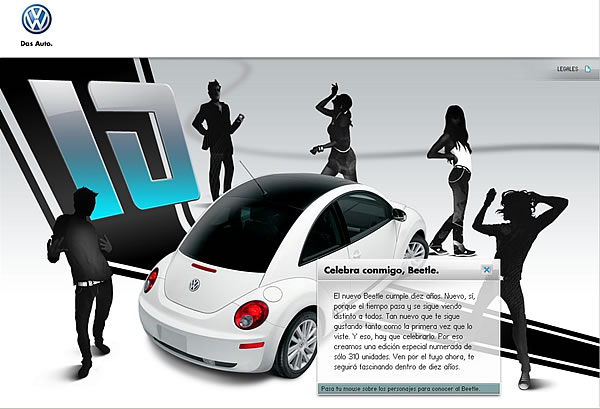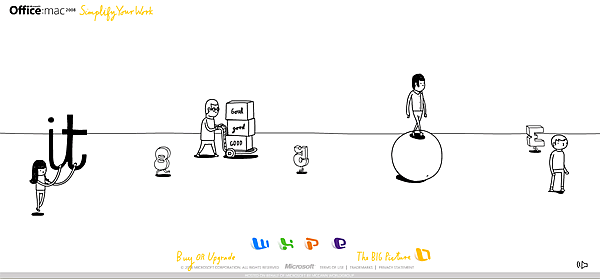Virgin Mobile in the US has launched an interesting website to promote their TXT service during the Valentine’s Day. The purpose of the site is to help people learn the fine art of sexy texting while promoting their cell phones and text messaging plans. A really good idea and implementation to engage users. Try it. Via ViralBlog
READING…
The future of mobile: QR Codes
Random Culture has an interesting post about Quick Response Codes, which are being used extensively in Europe and Japan for mobile marketing campaigns. These codes, created in Japan in 1994 by Denso-Wave are being used in marketing for mobile users to take a picture of the code or read a the codes with the cameras to trigger action on their mobiles, it could be to download some piece of content, get a message or go to a website. QR Codes might be placed in magazines, buses, signs, business cards to let users with the special software installed on the mobile to capture the image and executed the desired action. For more information go to Random Cuture or the Wikipedia.
Getting paid for blogging
Wired’s magazine issue 16.02 comes with some great articles, one of those talks about the initiative proposed by PayPerPost by which bloggers subscribed to this network are being paid for each post they make related to some of the products of the brands associated to the service. A really interesting concept that might come into a real good business. This blogging schema has been put on doubt because it might harm the authenticity of the blogosphere, but the founders of the service claim that they require bloggers to disclosure their relationship with PayPerPost for every post they are getting paid of. For more information, read Wired.
New Beetle: 10 years celebration
The New Beetle is ten years old and Volkswagen Mexico has launched a limited numbered edition to celebrate. They have also launched a special website for us to visit. A really good development with cool animations and transitions. Shame on the flash loaders, that are so hidden that the common user might not see them. (hint: see the blue bar at the top) The New Beetle is ten years old. New, yes, because time goes on and it keeps looking completely different from others. It is so new that keeps liking you so much as the first time you saw it. And that is for celebrating. Do you remember the first time you saw it? For the first time, a car that didn’t seem like any other, it was completely different. “Like ten years ahead”, you said. Almost like twenty, don’t you think so? Wait another ten years and you’ll see. In the meanwhile, Seguir leyendo
10 usability nightmares…
Smashing Magazine published a few months ago an interesting list of usability nightmares that you should be aware of: Hidden log-in link One of the most used links (if not the most) should be always placed in a relevant and visible position. Pop-ups for content presentation It is really not a good idea to open a pop-up window to show the content, at the end, browsers nowadays block automatically that kind of javascripts and so you’re forced to use the famous “if the window has not opened click here”. Dragging instead of vertical navigation There are some flash enthusiast that keep going under the idea that the user has to “discover” the way a site must be used. The dragging technique claims to break the scrolling paradigm and let users interact with the page dragging it instead of scrolling. This might become a new trend in the future but for Seguir leyendo
Simplify your work
Microsoft has launched a new website to promote Office 2008 for Mac. A really good approach with the simplification methaphora. The bad thing is when you want to “learn more” about the product, you are redirected to the traditional (and not-so-simplified) MS website. Simplify your Work Via Cpluv
Coca-Cola: The happiness factory
Coca-Cola has launched in France a new website that might extend the “Happiness Factory” concept to the online world. Regardless that the website takes a while to load, the graphics at the very first sight are really good. Once you start browsing you realize that in fact the development is too heavy, so it is difficult to really enjoy it. The advergame is really complicated. At the end, a really good effort but only enjoyable by those who have a broadband internet connection. Via Adverblog
Tangible Media: The future on the user’s experience
Along the time we have been forced to adapt our habits to new technologies that promise to facilitate the way in which we work. Thus, we have adopted the mouse and the keyboard as the main tools to interact with computers. We have also adopted the windows concept and the fact that we can only make one task at a time (minimize a window, scroll or change the window’s size are tasks that can’t be performed simultaneously) as our paradigm for human-computer interaction. Smashing Magazine published recently an article showing some improvements regarding the user’s experience. Cheoptics360 It is a product by Vizoo that can display 3D holograms with an altitude from 1.5 to 30 meters, regardless it is outside or inside. Reactable It is a collaborative musical instrument with a touchable interface in which many users can control the instruments simultaneously by moving or rotating physical objects that are Seguir leyendo
Tangible Media: El futuro de la experiencia del usuario
A lo largo del tiempo hemos tenido que adaptar nuestros hábitos a nuevas tecnologías que prometen facilitar la manera en la que trabajamos. De esta manera hemos adoptado al mouse y el teclado como las herramientas básicas de interacción con una computadora. Hemos también adoptado el concepto de las ventanas y el hecho de que sólo podemos hacer una cosa a la vez (minimizar una pantalla, hacer scroll o cambiarla de tamaño son tareas que no podemos hacer simultáneamente) como paradigma de la interacción humano-computadora. Smashing Magazine publicó recientemente un artículo donde muestra algunos avances en cuanto a experiencia del usuario se refiere. Cheoptics360 Es un producto creado por Vizoo que puede proyectar hologramas en 3D desde 1.5 hasta 30 metros de altura, tanto en interiores como en exteriores. Reactable Es un instrumento musical colaborativo con una interfaz táctil con la cual múltiples usuarios en simultáneo pueden controlar el instrumento Seguir leyendo
La analogía del iceberg
¿Qué es lo que hace a un website exitoso? Al contrario de lo que muchas personas (e inclusive algunas agencias) pudieran pensar, no es la imagen ni el contenido, sino todo lo que está debajo, aquello que lo sustenta y hace que todo funcione bien. Vía Isopixel me encuentro este interesante gráfico que, haciendo la analogía con un iceberg, muestra que hay más que un bonito diseño y un buen contenido en la lista de cosas a considerar cuando se desarrolla un website. El artículo original en inglés se puede obtener aquí.





